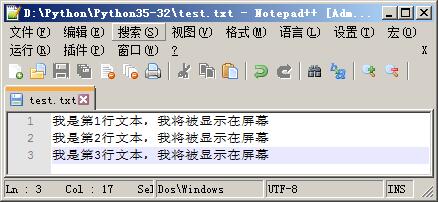python 文件操作--內置對象open
阿新 • • 發佈:2017-07-05
trac tool .text imp 缺省 support span seq com 





說明:
1. 函數功能打開一個文件,返回一個文件讀寫對象,然後可以對文件進行相應讀寫操作。
2. file參數表示的需要打開文件的相對路徑(當前工作目錄)或者一個絕對路徑,當傳入路徑不存在此文件會報錯。或者傳入文件的句柄。

>>> a = open(‘test.txt‘) # 相對路徑 >>> a <_io.TextIOWrapper name=‘test.txt‘ mode=‘r‘ encoding=‘cp936‘> >>> a.close() >>> a = open(r‘D:\Python\Python35-32\test.txt‘) # 絕對路徑 >>> a <_io.TextIOWrapper name=‘D:\\Python\\Python35-32\\test.txt‘ mode=‘r‘ encoding=‘cp936‘>

3. mode參數表示打開文件的模式,常見的打開模式有如下幾種,實際調用的時候可以根據情況進行組合。
打開文件時,需要指定文件路徑和以何等方式打開文件,打開後,即可獲取該文件句柄,日後通過此文件句柄對該文件操作。
打開文件的模式有:
- r ,只讀模式【默認】
- w,只寫模式【不可讀;不存在則創建;存在則清空內容;】
- x, 只寫模式【不可讀;不存在則創建,存在則報錯】
- a, 追加模式【可讀; 不存在則創建;存在則只追加內容;】
"+" 表示可以同時讀寫某個文件
- r+, 讀寫【可讀,可寫】
- w+,寫讀【可讀,可寫】
- x+ ,寫讀【可讀,可寫】
- a+, 寫讀【可讀,可寫】
"b"表示以字節的方式操作
- rb 或 r+b
- wb 或 w+b
- xb 或 w+b
- ab 或 a+b
註:以b方式打開時,讀取到的內容是字節類型,寫入時也需要提供字節類型
# t為文本讀寫,b為二進制讀寫
>>> a = open(‘test.txt‘,‘rt‘)
>>> a.read()
‘some text‘
>>> a = open(‘test.txt‘,‘rb‘)
>>> a.read()
b‘some text‘
# r為只讀,不能寫入;w為只寫,不能讀取
>>> a = open(‘test.txt‘,‘rt‘)
>>> a.write(‘more text‘)
Traceback (most recent call last):
File "<pyshell#67>", line 1, in <module>
a.write(‘more text‘)
io.UnsupportedOperation: write
>>> a = open(‘test.txt‘,‘wt‘)
>>> a.read()
Traceback (most recent call last):
File "<pyshell#69>", line 1, in <module>
a.read()
io.UnsupportedOperation: not readable
#其它不一一舉例了4. buffering表示文件在讀取操作時使用的緩沖策略。
0: 代表buffer關閉(只適用於二進制模式)
1: 代表line buffer(只適用於文本模式)
>1: 表示初始化的buffer大小
5. encoding參數表示讀寫文件時所使用的的文件編碼格式。
假設現在test.txt文件以utf-8編碼存儲了一下文本:


>>> a = open(‘test.txt‘,‘rt‘) # 未正確指定編碼,有可能報錯
>>> a.read()
Traceback (most recent call last):
File "<pyshell#87>", line 1, in <module>
a.read()
UnicodeDecodeError: ‘gbk‘ codec can‘t decode byte 0xac in position 8: illegal multibyte sequence
>>> a = open(‘test.txt‘,‘rt‘,encoding = ‘utf-8‘)
>>> a.read()
‘我是第1行文本,我將被顯示在屏幕\n我是第2行文本,我將被顯示在屏幕\n我是第3行文本,我將被顯示在屏幕‘
>>>

6. errors參數表示讀寫文件時碰到錯誤的報錯級別。
常見的報錯基本有:
‘strict‘嚴格級別,字符編碼有報錯即拋出異常,也是默認的級別,errors參數值傳入None按此級別處理.‘ignore‘忽略級別,字符編碼有錯,忽略掉.‘replace‘替換級別,字符編碼有錯的,替換成?.

>>> a = open(‘test.txt‘,‘rt‘,encoding = ‘utf-8‘)
>>> a.read()
‘我是第1行文本,我將被顯示在屏幕\n我是第2行文本,我將被顯示在屏幕\n我是第3行文本,我將被顯示在屏幕‘
>>> a = open(‘test.txt‘,‘rt‘)
>>> a.read()
Traceback (most recent call last):
File "<pyshell#91>", line 1, in <module>
a.read()
UnicodeDecodeError: ‘gbk‘ codec can‘t decode byte 0xac in position 8: illegal multibyte sequence
>>> a = open(‘test.txt‘,‘rt‘,errors = ‘ignore‘ )
>>> a.read()
>>> a = open(‘test.txt‘,‘rt‘,errors = ‘replace‘ )
>>> a.read()

7. newline表示用於區分換行符(只對文本模式有效,可以取的值有None,‘\n‘,‘\r‘,‘‘,‘\r\n‘)
>>> a = open(‘test.txt‘,‘rt‘,encoding = ‘utf-8‘,newline = ‘\r‘) >>> a.readline() ‘我是第1行文本,我將被顯示在屏幕\r‘ >>> a = open(‘test.txt‘,‘rt‘,encoding = ‘utf-8‘,newline = ‘\n‘) >>> a.readline() ‘我是第1行文本,我將被顯示在屏幕\r\n‘
8. closefd表示傳入的file參數類型(缺省為True),傳入文件路徑時一定為True,傳入文件句柄則為False。
>>> a = open(‘test.txt‘,‘rt‘,encoding = ‘utf-8‘,newline = ‘\n‘,closefd = False)
Traceback (most recent call last):
File "<pyshell#115>", line 1, in <module>
a = open(‘test.txt‘,‘rt‘,encoding = ‘utf-8‘,newline = ‘\n‘,closefd = False)
ValueError: Cannot use closefd=False with file name
>>> a = open(‘test.txt‘,‘rt‘,encoding = ‘utf-8‘,newline = ‘\n‘,closefd = True)
python 文件操作--內置對象open
